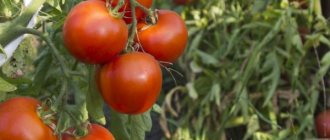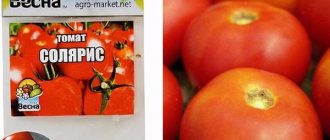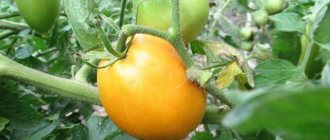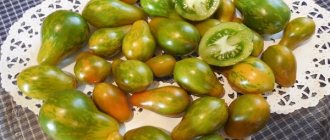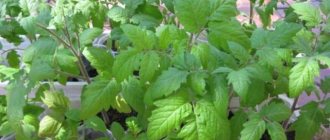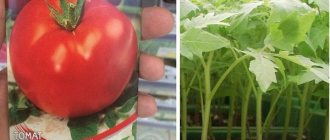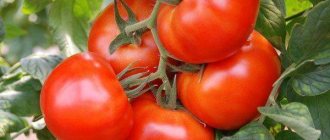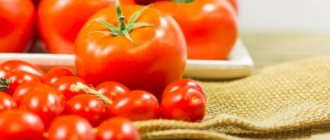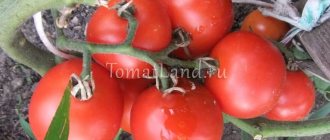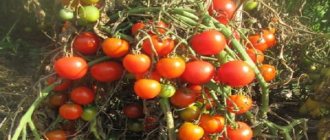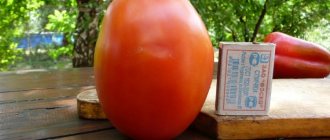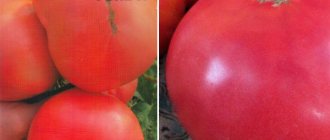Tomato Havana cigar - description and characteristics of the variety
Neither Wodan, an avid gardener and gardener, can imagine his property without tomatoes.
This versatile vegetable has long been used for preparing a variety of dishes, including canning, making ketchups, pastes and sauces. The Hawaiian Regalia tomato variety is distinguished by the fact that its fruits have an elongated shape, which is the reason for the name. Tomatoes are characterized by excellent taste and high yield. Suitable for growing on open ground and in greenhouses or greenhouses. Zopa of this variety belongs to the group of mid-season vegetables. From the basics of sowing seeds and the beginning of fruiting, 110-115 days pass.
Nosography of the variety
The plant is characterized by unlimited growth and a liana-like stem, reaching a height of 2 meters. The bushes are quite branched with a large number of light green leaves. The actinostele is strong and powerful and goes deep into the soil.
Tomato fruits have an elongated cigar-shaped shape, the salt of the tomato soil is bright red, the skin is strong and thick, not prone to cracking. Vodan tomato weighs approximately 150-200 grams. The length of a tomato fruit can decrease to 18 cm.
Tomatoes grow in clusters of 6-8 stuccos each.
Tomatoes are ideal for long-distance transportation. Due to the high characteristics of shelf life and durable skin, tomatoes are transported to other regions without the threat of losing a large amount of fruit. When fresh, they can be stored for up to 1.5 months. You can harvest up to 13 kg of tomatoes from one square meter.
Features of cultivation
A sample of Hawaiian cigar tomatoes is excellent for growing in open ground and in greenhouses. Planting is carried out using the seedling method. In order to obtain high-quality and healthy seedlings, you need to follow the rules in accordance with care immediately after sowing the seeds.
Seeds need to be purchased in a specialized store and treated with a weak solution of potassium manganese. For faster growth, you can soak them for 1-2 hours in a special growth accelerator. If you want the first shoots to appear as soon as possible, in this case you can wrap the seeds in a wet napkin or gauze overnight.
Preparation of planting material
Before sowing, you should stock up on soil, humus and suitable containers. When soil is purchased in a store, it already contains the necessary organic additives. But, if you use soil from your garden, you need to add fertilizer yourself. A good addition would be rotted rubbish or stove ash.
Before sowing seeds, garden soil needs to be heated in the oven at high temperature for 2-3 hours. This will help get rid of various types of fungal infections and viruses in the future.
Sowing seeds, picking, hardening
- The prepared fertilized soil is poured into the prepared boxes or another container. The seeds are sown in rows no deeper than 1 cm. The soil should be slightly moistened.
- From a bird's eye view, the boxes are covered with film or glass is placed to create a greenhouse effect.
- Boxes with seeds should be placed in a warm, sunny place.
- When the shoots appear and produce a union of 2-4 leaves, the plants are planted in a separate container. You can plant the seedlings in disposable cups.
- Before the seedlings are removed into the ground, the plants need to be hardened off.
They must adapt to the outdoor climate and low temperature conditions. To do this, seedlings in a water run for several days need to be exposed to fresh air for several hours. And just before planting, seedlings can be reserved outside. - Planting is carried out by preparing holes in the intended area.
The planting site should not be dark or too sunny. On one square meter of property you can plant 3-4 seedlings. The distance between the holes should be less than 50 cm. For better growth and getting rid of pests and diseases, seedlings need regular care.
Running for tomatoes Hawaiian cigar
- The soil should not be allowed to dry out; eggs love moisture. Therefore, they need to be watered as needed.
- In order to achieve better growth of bushes and obtain a richer harvest, it is necessary to carefully carry out hilling and loosening of the soil.
- We need to get rid of weeds in a timely manner.
- Several times a season it is necessary to inject complex mineral supplements.
- To get larger fruits, it is necessary to remove excess branches and leaves from the bushes.
- As they grow, so that the tomato bushes do not lie on the ground under the weight, they need to be tied to supports.
By following all the care rules, you can get an excellent harvest of red elongated tomato fruits.
Running for tomatoes Hawaiian cigar
- The soil should not be allowed to dry out; eggs love moisture. Therefore, they need to be watered as needed.
- In order to achieve better growth of bushes and obtain a richer harvest, it is necessary to carefully carry out hilling and loosening of the soil.
- We need to get rid of weeds in a timely manner.
- Several times a season it is necessary to inject complex mineral supplements.
- To get larger fruits, it is necessary to remove excess branches and leaves from the bushes.
- As they grow, so that the tomato bushes do not lie on the ground under the weight, they need to be tied to supports.
By following all the care rules, you can get an excellent harvest of red elongated tomato fruits.
Planting in a greenhouse
Good and high-quality seedlings - strong, not overgrown, with 8-9 true leaves. When planting, follow the scheme: two plants per square meter.
The holes are shed with warm water, the seedlings are carefully planted, and sprinkled with earth. It is advisable to choose a cloudy day for planting or transplant tomato seedlings in the late afternoon.
Temperature in the greenhouse: +20ºC…+25ºC, at night – not lower than +18ºC. It is also necessary to observe air humidity indicators - 55-65%, since dry air is also harmful to tomatoes, as is high humidity.
ON A NOTE! A greenhouse with tomatoes must be ventilated (vents, windows, doors), especially in hot and rainy weather.
The presence of shade in the greenhouse is not allowed; tomatoes should receive as much light and solar heat as possible. Aventyuniai loves warmth and light, and high yields cannot be obtained if the plants are shaded.
Advantages and disadvantages of the variety
The advantages of the variety include:
- consistently high productivity;
- unusual and beautiful shape of the fruit;
- excellent taste of pickled and salted fruits;
- excellent keeping quality and transportability of tomatoes;
- tomatoes do not crack and do not lose their appearance even when transported over long distances;
- long fruiting period;
- indeterminate plants allow rational use of greenhouse space.
The disadvantages include the following:
- fruits are too dense for fresh consumption;
- long-term fruiting is possible only in a greenhouse;
- requires pinching and tying up throughout the season.
If it’s your family’s tradition to salt tomatoes grown in your own garden, then you will appreciate the “Havana Cigar” variety. Without requiring much effort and effort, this tomato will bring a large harvest of high-quality fruits.
Growing and care
At the beginning of spring, seeds are prepared for planting. To do this, grains purchased or prepared in the fall are collected in a cloth bag and dipped for several minutes in a weak solution of potassium permanganate. Then the grains are taken out of the bag and washed in a colander with water to get rid of any remaining solution. Potassium permanganate is an antiseptic; it kills harmful microorganisms, thereby disinfecting the seeds.
Then the seeds are placed on gauze soaked in water and left for 2-3 days. This is necessary for the seeds to germinate slightly. In the future, the grains will sprout faster. Germinated seeds are placed in boxes covered with soil. The soil is purchased at the store, but sometimes gardeners take the soil directly from the greenhouse. You can add compost, humus or peat to the soil.
Boxes with seeds are placed close to the light source - the sun. Be sure to cover the top of the box with film. The temperature at which tomatoes grow is 22-25 degrees. When sprouts appear on the surface of the earth, the film begins to be lifted. But it is better not to remove it completely, as there is a risk that fragile plants may die. They are still very vulnerable to external conditions.
Seedlings should be kept in moist soil; the soil should not remain dry. A spray bottle will help to keep the soil moist. From the 3rd week of germination, an additive is added to the water to stimulate growth. These can be phosphorus-containing and nitrogen-containing substances, root. They promote the development of the root system and will significantly improve the condition of the seedlings.
If the tomatoes have grown quickly and the boxes are too small for them, then they are transplanted into larger containers. This process is called diving. Picking causes ambiguous and contradictory opinions among gardeners. It is carried out at your discretion. Bushes with 2-3 green leaves spring up.
Transplantation into open ground should be carried out in May. All tomatoes must be planted before summer, otherwise they will take a long time to ripen. After planting, the tomato bushes are watered generously and left to settle in the new soil.
Usually all tomatoes, without exception, take root. As the stem grows, extraneous grass will grow near the plants. It must be removed, as it takes some of the nutrients from the ground, thereby slowing down the development of the tomato bush.
When the bush reaches a height of 30 centimeters, tying is carried out. If the greenhouse already has a trellis, then that's great. If there is no trellis, then you need to string a wire along the top of the greenhouse. Twine is tied to the wire. The second end of the twine is attached to the crown of the stem under tension. It turns out that the twine seems to pull the tomato bush up. The garter again accelerates the growth and development of tomatoes, and also relieves the load on the stem.
Tomatoes set in early summer and then begin to increase in volume. The fruit is initially green, but gradually the color begins to change and reaches yellow. This usually occurs in the second half of summer. When grown outdoors, the ripening process slows down by 2-3 weeks.
What summer residents say about Havana cigar tomatoes
To get more complete information about the tomato variety, it is better to look for reviews from gardeners. They share their impressions and give advice.
Nina Alekseevna. I planted tomatoes for the first time. Mainly to see if they really taste as good when marinated as others say. Next year will tell. Then a decision will be made about whether to grow them.
Cigar-shaped tomatoes attract not only their shape, but also the excellent taste of pickled fruits.
The Havana cigar tomato has a unique shape, which is why it got its unusual name. Farmers choose Havana cigar for planting in their gardens due to its large yields and excellent taste. A detailed description of the variety allows a summer resident who does not yet have much experience in growing tomatoes to make the right choice.
Positive and negative characteristics
For the convenience of the gardener, the description of the properties of tomatoes is divided into positive and negative. Having studied this information, he decides whether to plant the plant on his site.
Pros:
- Productivity.
- Excellent taste of pickled fruits.
- Tomatoes do not crack, are stored for a long time, and retain their excellent appearance during long-term transportation.
Minuses:
- Treatment for diseases is required.
Fruiting of the Banana Legs variety
The first thing gardeners pay attention to is the color and shape of the vegetable. The shape of this plant is strikingly different from other round tomato fruits.
Banana legs even somewhat resemble fruit from exotic countries. The color of the variety is bright yellow, this is an important distinguishing feature of the plant. Unripe fruits have a delicate green tint, which disappears as soon as the fruit ripens. Banana legs are a raceme variety with up to 14 fruits growing on each branch. Vegetables ripen at the same time, which is convenient in terms of harvesting and preparing tomatoes.
The weight of one fruit does not exceed 80 grams. This is if we talk about growing plants in open ground. By growing the variety in a greenhouse, you can get a fruit weighing up to 130 grams. The tomato can grow up to 12 centimeters long. The taste of tomatoes is also very different from ordinary varieties. Tomatoes have fleshy, tender flesh with very few seeds.
And the skin of the tomato is very dense, which is very important when preserving. The taste is slightly sweet, with a slight sourness and a subtle hint of lemon
Important to know: The Banana Legs plant should not be pinched, but they cannot do without pinching. Fruits can be stored for quite a long time without changing the taste and density.
They tolerate long-term transportation well, if collected and packaged unripe.
Fruits can be stored for quite a long time without changing the taste and density. They tolerate long-term transportation well if collected and packaged unripe.
Harvest volume and application
The criteria for choosing a variety are not only external signs and characteristics, but also the yield of the species. From 1 m2 you can get up to 12 kg of fruit. One plant produces about 2 kg.
The scope of application is wide, since the fruits are universal. They are used for:
- Whole fruit canning.
- Preparation of juices, sauces, ketchups, tomato paste.
- Fresh salads and table decorations.
"Hawaiian Cigar" is a champion in terms of positive reviews regarding the taste of pickled fruits.
Tomato Magnus
Early ripening (95 days from germination to the beginning of ripening), semi-determinate, high-yielding tomato hybrid from Dutch breeders. Recommended for growing in greenhouses.
The bush is densely leafy, up to 1.5 meters high. Medium sized leaf, green. The inflorescence is simple. The manufacturer recommends forming the plant into 1 stem.
Basic qualities of fruits
The fruits are flat-round, very dense, slightly ribbed, red in color at maturity, weighing 130-150 grams, good (for a hybrid) taste. These tomatoes have good keeping quality and transportability. The purpose is universal.
This hybrid is highly resistant to root-knot nematodes, fusarium, cladosporiosis, verticillium, TMV, and is tolerant to late blight.
Advantages of the hybrid: it sets fruit well in stressful and unfavorable conditions, the fruits are resistant to cracking.
Planting pattern: 50 x 40 cm, planting density - 6 plants per 1 sq. m.
The Magnus F1 tomato is included in the State Register of the Russian Federation for growing under film covers in private household plots.
Originator: Monsanto (Holland).
Video: how to form a tomato into 1 and 2 stems
If you grew Magnus tomatoes, please write what the yield was in your climatic conditions? Did you like the taste of the fruit? Will you grow this tomato again or find a more productive hybrid? Briefly describe the advantages and disadvantages of this tomato. Thank you!
Your reviews of the Magnus tomato and additions to the description will help many gardeners evaluate this hybrid objectively and decide whether it is worth planting or not.
Famous high-yielding low-growing varieties of tomatoes for the greenhouse
Many gardeners do not have time for pinching, forming bushes, or properly distributing tomato clusters. That is why they choose the best low-growing varieties of tomatoes for the greenhouse, in other words, non-sapling ones, since they are extremely easy to care for. Even novice gardeners can cope with the intricacies of agricultural technology.
There are a great many such varieties. Among similar vegetable crops that can be grown in greenhouses, it is worth noting the following versions:
- "Orange Princess";
- "Duckling";
- "Little Red Riding Hood";
- "Magus H";
- "Aztec".
Variety "Azhur F1"
Numerous reviews of the Azhur F1 tomato indicate the excellent characteristics of this hybrid form of the plant. This variety is low-growing and is excellent for growing in a greenhouse. The height of the standard bushes of the plant ranges from 60-90 cm.
But summer residents appreciate other properties in this variety. The hybrid is resistant to most diseases, including root and blossom end rot, and its fruits are not afraid of cracking.
Another description of the variety and characteristics of the Azhur tomato allow us to talk about the plant’s resistance to temperature fluctuations and adverse weather conditions.
Variety "Betta"
Not only this hybrid variety is very popular with summer residents who prefer to cultivate low-growing tomatoes in greenhouses. Among such crops, Betta tomatoes deserve special attention.
This vegetable crop pleases not only with its short growth, but also with the speed of fruit ripening. These are ultra-early ripening tomatoes, which are characterized by unpretentiousness and ease of cultivation. When describing the Betta tomato, gardeners note the variety’s resistance to low temperatures.
Another advantage is that the tomato is without pinching, and tying up the plant is not required.
Among other tomatoes suitable for growing in a greenhouse, there is o. It is necessary to make a reservation right away that this variety does not belong to the category of low-growing, since it reaches a height of 190-210 cm. But reviews of the Watermelon tomato are the most positive, since the appearance of the vegetables and their taste are excellent.
"Axanta" is another tomato suitable for cultivation in greenhouse conditions. This variety is very compact and neat. A detailed description of the Axantha tomato also allows us to talk about:
- large-fruited;
- high yield;
- possibilities of growing in open ground;
- no need for tying;
- excellent taste.
There are also low-growing varieties of tomatoes for greenhouses, which are well known to many gardeners. An excellent solution is the Aztec vegetable crop. The dwarf version can also be grown on balconies and in apartments. This type of tomato can be planted in flower pots and small tubs. The variety is often classified as cherry.
Many gardeners give good reviews about the Semenych tomato. The height of this vegetable crop usually does not exceed 1 m. The fruits of this variety are optimally suited for canning. The tomatoes are medium in size. They have a pleasant taste with a spicy, expressive sourness. The dense skin of hybrid vegetables perfectly protects them from cracking and deformation.
The Admiralteysky tomato, which is characterized by its small height, is also suitable for growing in a greenhouse. It ranges from 50 to 100 cm.
Among other features of the vegetable crop, it is worth noting the high yield, friendly yield of fruits, and excellent taste of the tomato. Their flesh is very dense, juicy, and fleshy.
The variety, which can also be cultivated in open beds, belongs to the salad category. However, the fruits obtained from these bushes can be used for pickling and canning.
But the variety cannot be called short-growing, since its bushes are very tall and powerful. They grow up to 1.5-2 m. That is why they definitely need tying to a net or trellis and pinching. The resulting harvest is universal.
Vegetables are good in salads, fresh, and in winter wraps.
Another wonderful variety recommended for cultivation in a greenhouse is the Ashkelon tomato, which produces a rich harvest.
This hybrid variety is also not short-growing, since its height usually reaches 1.8 m. The main advantage of the vegetable crop is its resistance to yellow leaf curl virus, Fusarium and Verticillium wilt, and tobacco mosaic virus.
Many gardeners give numerous positive reviews about the Ballerina tomato. This low-growing tomato variety is excellent for greenhouses and film shelters. The bushes of this plant are small and compact. They do not grow more than 60 cm in height. Summer residents also highly value other features of this vegetable crop.
The variety is attractive:
- resistance to fungi;
- the ability to resist pests;
- excellent taste of the fruit;
- short ripening period of tomatoes.
Among other varieties stands o. This is an ideal solution for greenhouse and greenhouse conditions. The low-growing plant is surprisingly productive.
If you adhere to the basic rules of agricultural technology and properly care for such tomatoes throughout the season, then from 1 bush you can get about 40 kg of ripe, tasty vegetables of a rich orange hue.
The Grandmother's Gift tomato is intended exclusively for indoor soil, attracting gardeners with its unique properties. It can be cultivated in glass, film and polycarbonate greenhouses and greenhouses.
It is resistant to powdery mildew, late blight, fusarium, tobacco mosaic virus and cladosporiosis.
Another excellent solution for a greenhouse is the Family F1 tomato, the height of which varies from 50 to 100 cm.
This hybrid variety is characterized by high yield, resistance to adverse factors, and excellent taste of ripe vegetables. The “Family” hybrid allows you to harvest about 18 kg of delicious ripe tomatoes from just 1 m².
This vegetable crop is considered universal, but it is important to allow the fruits to fully ripen on the bushes. Only compliance with this condition ensures excellent taste of vegetables.
READ MORE: Tomato Caramel: characteristics and description of the variety, yield with photos
This variety is often cultivated for commercial purposes, since the ripe fruits tolerate long-term transportation well. Ripe vegetables are often used to make juices, salads, purees, sauces and soups.
They are tasty fresh, but whole-fruit rolls for the winter are especially appetizing.
Relatively recently, the Babushkino Lukoshko tomato was developed, which immediately attracted the interest of farmers and private gardeners. The variety was born only in 2015, but some of its features are already known.
Breeders indicate the need to cultivate plants in greenhouses or greenhouses. But the Babushkino Lukoshko tomato is unlikely to be undersized.
The exact height of the variety has not yet been indicated, but it is believed that it will reach 1.5 m.
The Alesi F1 tomato, which belongs to the category of hybrid crops, is also suitable for growing in a greenhouse. This variety is good for year-round cultivation indoors. Gardeners like this variety with its early fruit ripening period. Vegetables are distinguished by good transportability, dense structure and skin, which prevents tomatoes from cracking and deforming.
The low-growing Havana cigar tomato is an excellent solution for greenhouses and film shelters.
An amazing feature of the variety, according to reviews from gardeners and comments from breeders, is its high yield. From each branch of the bushes of this vegetable crop you can pick up to 30 ripe, tasty, juicy fruits. That is why the long-fruited variety is often called a real champion in terms of productivity.
Many summer residents give excellent reviews about the Red Banana tomato. According to them, bushes of this variety grow up to 120 cm in height. So the variety cannot be called undersized. However, the vegetable crop gives an excellent harvest when grown in greenhouses.
The variety allows you to harvest up to 3 kg of delicious, richly colored fruits from each bush. To obtain abundant harvests of this crop, it is recommended to systematically feed the plant, provide it with optimal watering and access to a light source.
Hybrid tomato Grandma's Pride F1 is another popular variety intended for cultivation in closed ground. An early-ripening vegetable crop usually grows up to 50-70 cm. You can get up to 5.5 kg of vegetables from each bush. The fruits of this variety perform well in pickling. Vegetables are delicious in salads, stewing, canning, and fresh.
Positive reviews about the Afen F1 tomato made this variety very attractive among gardeners. The hybrid is recommended for cultivation indoors, but it cannot be classified as a low-growing variety.
Its bushes can grow very large in height. Gardeners are attracted to this hybrid form by the excellent taste of the fruit and resistance to most known diseases.
The vegetable crop is unpretentious and simple in agricultural technology.
It is also worth noting low-growing varieties of tomatoes that can be grown in greenhouses and in urban apartments. These varieties include tomatoes:
- "Akulina";
- "Bullfinch";
- "Severenok";
- "North F1".
Listed above are only the most famous high-yielding tomato varieties suitable for growing in greenhouses. As practice and reviews from gardeners show, there are much more such vegetable crops.
How to care outdoors
Watering
The soil should not be too wet to prevent diseases of the root system, so watering should be done as the soil dries, every 5-7 days. The main thing: do not allow the soil to dry out during the period of setting tomatoes and their ripening.
Feeding
When ovaries begin to appear on the bush and future tomatoes are formed, the plant definitely needs additional feeding. To do this, complex mineral fertilizers are applied to the bush along with watering.
Important! The application of fresh manure should be avoided, as this is a very active fertilizer that can harm young tomato bushes
Stepsoning
For indeterminate varieties, the pinching procedure is integral, since it helps the plant to ensure effective formation of ovaries and good development of fruits. Removing side shoots accumulates the strength of the bush and it produces a harvest with large fruits.
General description of the variety
The Havana Cigar tomato variety was bred by Siberian agro and is suitable for growing in any geographical area of Russia in protected soil conditions.
The tomato belongs to the mid-early group, which means that 110-115 days will pass from germination to the first harvest. The plants are characterized by an unlimited growth pattern and liana-like stems. The bushes are branched with a lot of foliage of a simple type and light green color. The root system is very powerful and goes deep into the ground.
The fruits have an unusual elongated cigar-shaped shape, due to which the variety received its original name. The average weight of a tomato is about 150-200 grams, and the length can reach 18 cm. The cigar fruits are collected in simple double-row clusters of 6-8 pieces. The color of tomatoes when fully ripe is traditional red. The pulp of the fruit is small-chambered and dense, the skin is durable and not prone to cracking. Tomatoes of this variety are ideal for pickling and winter preparation. When processed, they do not lose their beautiful shape and good density. An undoubted advantage is that the fruits on the bushes have almost the same size and shape. These qualities are highly valued by housewives in tomatoes for pickling.
“Siberian Garden” characterizes the variety as high-yielding and numerous reviews from summer residents confirm this. From one square meter per season you can get 10-12 kg of marketable fruits.
Tomato Hawaiian pineapple - description and characteristics of the variety
Description
The fruits acquire a rich orange color when ripe. Transplants are tall, bushes up to 2 m. Plants need shaping and staking. Fruits can be consumed without heat treatment, as well as for the purpose of preparing ketchup, paste, and juice. Due to the large size in (avoidance of whole-fruit canning is not used. In open ground, ovaries are observed in excess than under cover. The fruits contain more than enough seeds, the pulp is very sweet and tasty.
Growing and care
The Hawaiian pineapple tomato is a deadly beautiful, but capricious plant. It is important for him to know warmth, but he also does not like overheating, and drafts are also unacceptable. The amount of watering should be careful - tomatoes can easily be over-watered or over-dried.
The Hawaiian pineapple variety cannot be grown in open ground in central Russia; at a minimum, the plant must grow sawdust in a greenhouse. Most often, this crop is grown from seedlings, because from the first shoots to the appearance of flowers they take about 100 days. The variety grows well in the middle zone near the condition of following all the rules and having a greenhouse or balcony/veranda.
The variant is characterized by fast ripening, abundant harvest and tasty yellow fruits. They are suitable for open ground purposes and, if you follow all the rules, will not cause unnecessary trouble.
Propagation from seeds
Tomato seeds are stored at a temperature of about 10 degrees in a dry place. If all conditions are met, they can protect their properties for up to 4 years. Temperatures below zero kill the super elite.
- Without stimulation, tomato seeds germinate in 10-12 days. Considering that growth and development can reach 100-110 days, it is better to intensify. Ant. slow down their pecking. The planting material is sorted, removing all deformed and small specimens, and therefore disinfected in a strong solution of potassium permanganate for 15 minutes.
- The seeds are kept at a temperature of 25 degrees until they hatch; the adhesive should remain moist.
- If planting in open regolith is intended, then hardening is also expected. To do this, the swollen moura are kept warm during the day - about 20 degrees - and put in the refrigerator at night (where the temperature is about 4-5 degrees). This regime should be maintained for 3-5 days. When the first shoots appear, the film is removed and the tar pot is moved to the windowsill. Compost made from plant residues is ideal for young plants.
- The Hawaiian pineapple variety, like all yellow varieties of tomatoes, is capricious in terms of transplantation. The root company is having a hard time recovering, which is affecting growth. Therefore, it is a wise decision to grow seedlings little by little in peat bags. In this case, it’s better to prepare the following mixture: for 8 parts of humus, take 2 parts of potassium, 1 part of mullein and 1 teaspoon each of superphosphate, potassium salt and urea.
- Before the early harvest, it is necessary to determine the time of planting. If aeroponics is planned in an unheated greenhouse or under a film, then the planting time is the end of February - beginning of March. It is allowed to sow mora at the end of March and after 30-35 days plant it in the planned area. The main thing is to have time to sow the seeds before April, otherwise the tomato will bloom too late and will not have time to ripen.
By mid-March, the seedlings should be strong. There should be 5-6 leaves. The pot is how to be big enough. It is better to water the seedlings in the evening hours.
Feeding and prevention
- Using modern complex fertilizers, it is possible to correct growth processes without the use of stimulants and genetic engineering.
- When fertilizers are added to the soil, dissolution occurs slowly; positive effects on plants appear within two years. These drugs are environmentally friendly. Residues in the fruits of uninhabited (=sparsely populated) tomatoes pose a health hazard.
- Biological products increase productivity, stimulate plant growth, and strengthen them.
The variety grows well in the middle zone, provided that all rules are followed and a greenhouse is available. The main thing is to wait until April to sow the seeds. By following the growing rules and carrying out a set of plant protection measures on time, you will be able to obtain a well-organized harvest of large, orange, very sweet Hawaiian pineapple tomatoes.
Growing the variety
Let's look at how the variety is planted and cared for. The variety can be grown both in open ground and in greenhouse conditions.
Like many other tomatoes, the Hawaiian tomato is grown in seedlings. It is recommended to plant the sprouts in separate containers 2 months before they are planned to be planted in a permanent place. The longer the cold season in the area where cultivation is planned, the later the seedlings should be planted.
In this case, it is necessary to follow several mandatory techniques:
- Diving seedlings into several containers.
- Mandatory hardening of seedlings before moving them to a permanent place. Preparing plants for sunlight and other natural phenomena.
- Constant feeding of the soil with the help of special preparations that will make plants grow faster.
If you comply with all the above requirements, the seedlings will be much stronger and will not experience much stress when you transplant the bushes to a permanent place in the ground or greenhouse.
It is recommended to place no more than five bushes per 1 m² of soil. Watering the plants is carried out in the evening, and you need to monitor the water temperature - it should be warm. Hilling and weeding also need to be done at certain intervals. This will prevent plants from being damaged by common diseases.
When choosing this variety, summer residents pay attention not only to the strange appearance, but also to the yield of the variety. With 1 m², a farmer, under proper conditions, can get about 12 kg of tomatoes. On average, 2 kg of fruits are harvested from one bush.
Thanks to the excellent taste of tomatoes and their thick skin, which prevents the fruit from cracking, they have gained such popularity among gardeners. Reviews from summer residents indicate that tomato can be widely used in cooking.
Some prefer to can these tomatoes whole, others eat them exclusively fresh and add them to salads, many are inclined to believe that tomatoes produce very tasty juice and puree. Tomatoes are also suitable for making gravies, sauces, and ketchups. They make excellent vegetable snacks, side dishes and hot dishes.
The “Havana Cigar” variety was appreciated even by the truest gourmets of tomato preparations. This tomato is famous for its high and stable yields of excellent quality fruits, which are ideally suited for various winter preparations and pickles.
Care technology
In order to get a rich harvest of Hawaiian pineapple tomatoes in the summer, you need to provide at least minimal care for them. It involves timely transplanting of seedlings, watering plants, hilling the soil, and destroying weeds and pests. Also disease control, tying, mulching bushes and timely harvesting.
Water the tomatoes daily with water at room temperature. Water is directed only under the root system, avoiding contact of leaves and stems with it, in order to prevent the greenery from being burned by the sun's rays
It is also important to consider weather conditions when watering. If it rains, watering is skipped
On the contrary, in hot weather, plants are watered more intensively.
After watering, it is recommended to loosen the soil in the holes and remove weeds at the same time. Mulch and tie up the bushes as they grow, approximately every 2 weeks. For this purpose, supports, thread or special structures are used.
Diseases and pests are controlled through the use of insecticides, as well as through timely care of plantings.
Growing technology
After reading the description, characteristics, reviews of yield, and photos of Gary O Sen’s tomato, it becomes clear that the variety makes high demands on growing conditions. You can count on a good harvest only if you follow the basic technology of cultivating the crop.
Since the variety is considered early, it is necessary to plant seeds for seedlings 50 days before the planned planting of plants in the greenhouse. Seedlings need special care. First of all, this concerns watering and lighting. Watering must be of high quality and regular. However, it is advisable to avoid stagnation of water.
Note! A few days before picking, the seedlings should be well watered. For irrigation, you can only use warm water. As for the temperature, it is worth maintaining the indicators within 17-18 degrees Celsius
If you follow the basic rules of care, the first shoots will appear within a week. First of all, the soil must be prepared. Tomatoes prefer to grow on loose soil. The soil should consist of compost and wood ash. If desired, compost can be replaced with bird droppings.
As for the temperature, it is worth maintaining the indicators within 17-18 degrees Celsius. If you follow the basic rules of care, the first shoots will appear within a week. First of all, the soil must be prepared. Tomatoes prefer to grow on loose soil. The soil should consist of compost and wood ash. If desired, compost can be replaced with bird droppings.
As soon as the seedlings get stronger, you can transplant them into the ground. Plant care is normal. It is necessary to carry out watering, loosening, fertilizing, and weeding. Such simple procedures will help you get a good harvest in the future.
Watering must be done in a timely manner. Both the lack and excess of moisture in crops are viewed negatively. In everything it is necessary to observe moderation.
As for feeding, the procedure is not necessary. If the plants are fragile, you can add fertilizer. Otherwise, the event is not worth holding.
Tomatoes do not like weeds. Therefore, as weeds appear, they need to be removed from the site.
Note! After watering, it is necessary to loosen the soil. This will get rid of the soil crust.
An important procedure is pinching the tops
This is done so that the plants develop and the fruits accumulate nutrients.
An important procedure is pinching the tops. This is done so that the plants develop and the fruits accumulate nutrients.
Agricultural technology
Sowing seeds
Tomatoes with medium ripening periods, which include the “Havana Cigar” variety, are recommended to be sown 60 days before transplanting into the greenhouse. Each summer resident can determine the transplant date from which the sowing time should be counted, based on the geographical location of his region. Characteristic features of this period are the absence of night frosts and the air temperature not lower than 15 degrees during the daytime and not lower than 10 degrees at night.
Land for planting is stored in the fall or special soil for tomatoes is purchased in the spring. In any case, immediately before planting, the composition is disinfected using any of numerous methods. For example, pour a solution of potassium permanganate or pour boiling water over it.
READ MORE: Apricot Countess variety description photo reviews
Self-collected seeds should be processed to reduce the risk of disease. To do this, they are soaked for a day in a brown iodine solution. Then washed and dried. Additionally, you can treat the planting material with growth stimulants. You can buy them ready-made or prepare them from what you have on hand. Here are some recipes:
- aloe juice, squeezed from three-year-old leaves of the plant and diluted in half with water;
- undiluted potato juice from pre-frozen vegetables;
- honey solution (teaspoon per glass of water).
Each of these solutions has a large number of useful substances, including biologically active ones, which have a positive effect on seed germination and strengthen the immunity of future plants.
Prepared seeds are sown in common containers. After germination in the phase of two or three true leaves, the strongest seedlings are selected and planted in individual pots.
Seedling care
Caring for small tomatoes is simple, but at the same time very important. It comes down to meeting the following conditions:
- air temperature: during the day 18-22°C and at night 9-10°C;
- twelve-hour daylight hours (additional illumination when there is a lack of natural light);
- regular but moderate watering (avoid getting water on the leaves of the plants);
- air humidification during the heating season;
- fertilizing if necessary.
The originator of the variety recommends forming plants of this variety into 2 main stems to obtain maximum yields. This means that after transplanting into the ground, in addition to the main stem of the plant, it is necessary to leave another shoot for growth. It is easy to identify: this is the strongest stepson that will appear on the main trunk, after 6-8 leaves under the first fruit cluster of the plant.
The remaining side shoots must be removed during the entire fruiting period, leaving small stumps of 1-3 cm. In addition, it is necessary to periodically lighten the plants, that is, remove the leaves under each fruit cluster after the fruit has set on it. The lower leaves of the bushes must also be removed; they no longer play a role in the process of photosynthesis, but late blight is the first to be affected.
The planting scheme with this design of bushes should be as free as possible. More than three plants should not be planted per square meter. There are vegetable growers who prefer, despite the recommendations of manufacturers, to plant tomatoes in one main trunk. In this case, up to four bushes can be planted per square meter. The best option is to plant plants in two rows in a checkerboard pattern.
Since the Havana Cigar variety is a tomato with an unlimited growth type, the crown of the main stem is pinched off about a month before the onset of stable cold weather. To do this, after the uppermost fruit cluster with already set tomatoes, leave a few leaves, and break off everything higher. This procedure will stop the growth of the plant and allow all the fruits to fill and ripen.
An important component of the entire process of caring for tomatoes of this type is tying up the bushes. The liana-like stems of this variety tend to fall onto the garden bed after transplantation. Therefore, they are immediately tied up and continue to do so throughout the season as the stems grow. Tall metal fittings, strong wooden stakes, and coarse mesh are suitable as supports. Well-tied tomatoes receive more light and oxygen, which means they get sick less and bear fruit better.
Watering and fertilizing
This variety does not require special agricultural techniques for watering. It is necessary to ensure that the water temperature is not lower than 22 degrees, and that drops do not fall on the leaves and stems. It is important to water regularly. The impressive size of the vegetative mass of plants and a large number of fruits require sufficient moisture. If you overdry the soil and then overwater it, the fruits begin to shrink and crack.
Over a long period of fruiting, plants take all nutrients from the soil and therefore it is necessary to feed Havana Cigar tomatoes at least three times a season. The first time - two weeks after planting, the second - during the flowering period of the 2nd cluster, and the third - after harvesting the first tomatoes. The composition and norms of fertilizing are determined based on the condition of the soil and focusing on the appearance of the plants.
The harvesting method depends on how the fruits are planned to be used in the future. For immediate fresh consumption, fully ripened tomatoes are removed from the bush, as they are stored for no more than 5-10 days. The same ripe fruits are used for juices, tomato pastes and lecho. Large volumes of crops are well stored until they are salted or pickled if they are collected in their brown form. For long-term storage, tomatoes are collected at the stage of milky ripeness or green.
It is important to remember that only healthy tomatoes without signs of damage are suitable for long-term storage. It is best to harvest in the morning and in dry weather, when the fruits are most elastic. For storage, it is more rational to use wooden boxes, the bottom of which is lined with straw. The tomatoes themselves are tightly wrapped in paper and laid in two or three layers, with the stalks facing up. In cellar conditions and protected from excess light, the fruits are stored for several months.
To store the tomato harvest on balconies or loggias at temperatures up to five degrees below zero, it is good to use the same wooden boxes, but filled with heat-insulating material (polyurethane foam balls). Such material will not allow the fruits to wrinkle and protect them from frost.
A week before the planned use, the stocks with the harvest are moved to a warm place, where the fruits will immediately begin to ripen and will be ready for consumption in 3-5 days.
Advice! Before storing tomatoes for long-term storage, wipe them well with vodka or diluted alcohol. This treatment will destroy all bacteria and extend the shelf life.
If you allow the bushes to become infected with diseases, then there is practically no chance of saving the plants. Sick seedlings will have to be mercilessly removed from the garden. Therefore, it is better to follow the basic rules for maintaining plantings and carry out regular preventive treatments.
Basic content rules include:
- disinfect the greenhouse twice a year (spring and autumn);
- annually replace the top layer of soil in the greenhouse, or carry out its disinfection;
- in the fall, burn the tops or take them outside the site;
- When watering, avoid getting water on the plants;
- regularly ventilate the greenhouse;
- avoid mixed plantings (only tomatoes should grow in the greenhouse);
- Regularly carry out pinching and lightening of plants;
- strictly follow the planting pattern.
To prevent diseases, tomatoes are sprayed with the following compounds:
- 1 liter of yogurt and 15-20 drops of iodine are diluted in 10 liters of water;
- per 10 liters add 35 drops of iodine and 1 tbsp. a spoonful of potassium chloride;
- pink potassium permanganate solution;
- 300 gr. wood ash is diluted in a bucket of water, then filtered thoroughly;
- 500 grams are infused in a bucket of water. chopped garlic for 24 hours, filter before use.
A spray bottle is best suited for processing, which will thoroughly moisten each leaf of the plants.
Tomato care
Medium-sized Aventyuniai is recommended to be grown using trellises. This will provide the tomato bushes with uniform lighting and make caring for the plants easier.
Watering depends on the weather: on hot days water more often, on cloudy days - less often. Tomatoes love plenty of watering to keep the soil well moistened. But at the same time, moisture must not get on the leaves of plants, flowers and fruits.
In greenhouses, the best option is drip irrigation, as well as watering into holes or furrows. Loosening is mandatory, as it enriches the soil with oxygen and prevents the appearance of a crust on the soil surface.
Mulching is recommended - hay, peat, sawdust. The mulch layer should be within 5-7 cm. This makes it possible to retain moisture in the soil, but at the same time avoid waterlogging, which this variety does not like so much.
To increase productivity, it is necessary to fertilize tomatoes:
- 20 days after planting, diluted mullein and nitrophoska are used. At least half a liter of nutritional composition is added to each plant.
- When the tomatoes begin to bloom, carry out a second feeding. They use superphosphate, potassium sulfate, and also diluted poultry droppings (you can also use mullein).
- After 10 days, the tomatoes are fed with sodium humate, potassium fertilizers, and complex formulations are used.
ON A NOTE! There are many different ready-made formulations such as Kemira Plus on sale, recommended for feeding tomatoes. They can always be used, but at the same time comply with application deadlines and standards.
Judging by the reviews of those who have already grown Aventyuniai, the tomato bears fruit best when the bush is formed into one stem. Stepchildren are removed every five days, preventing them from overgrowing.
